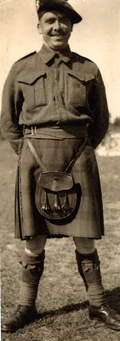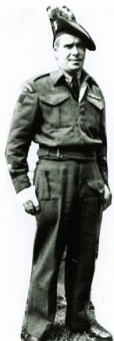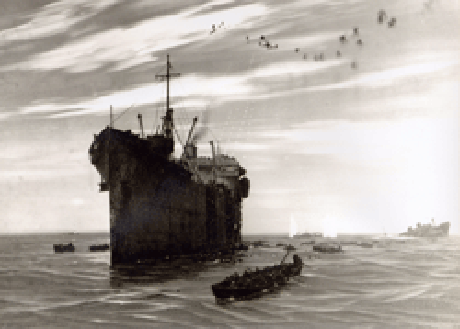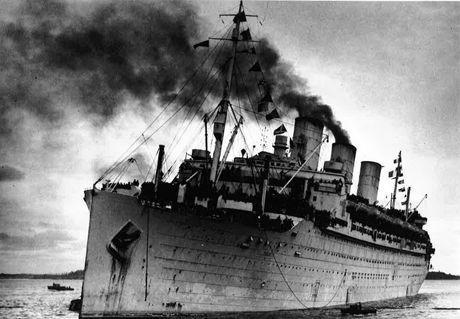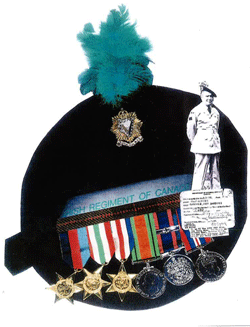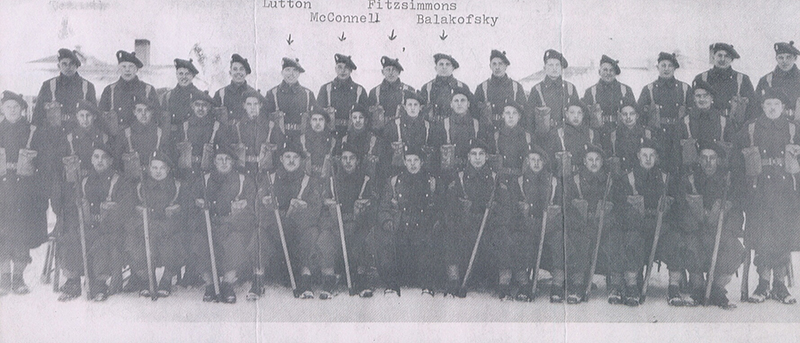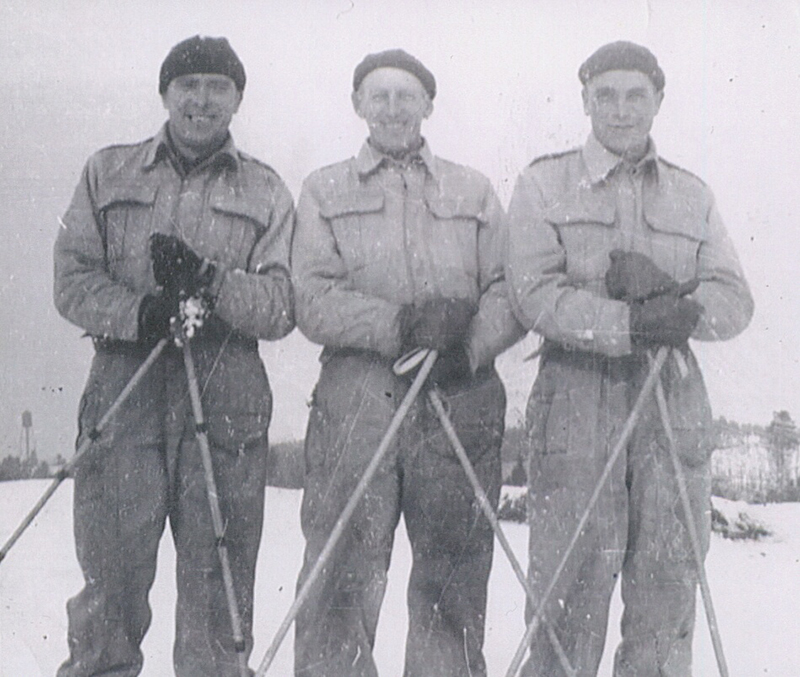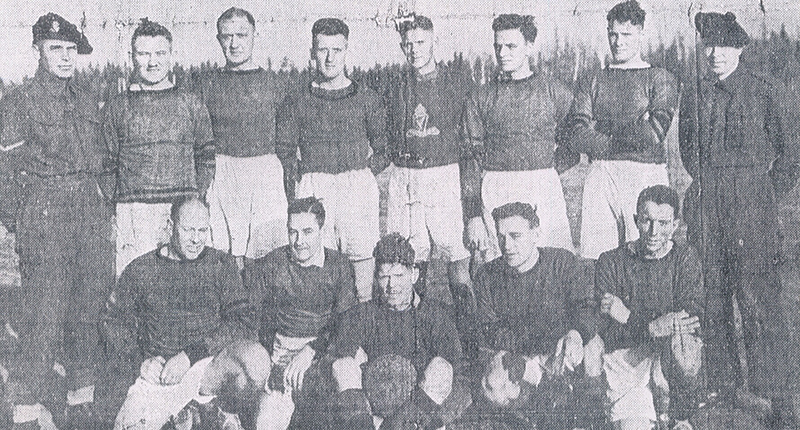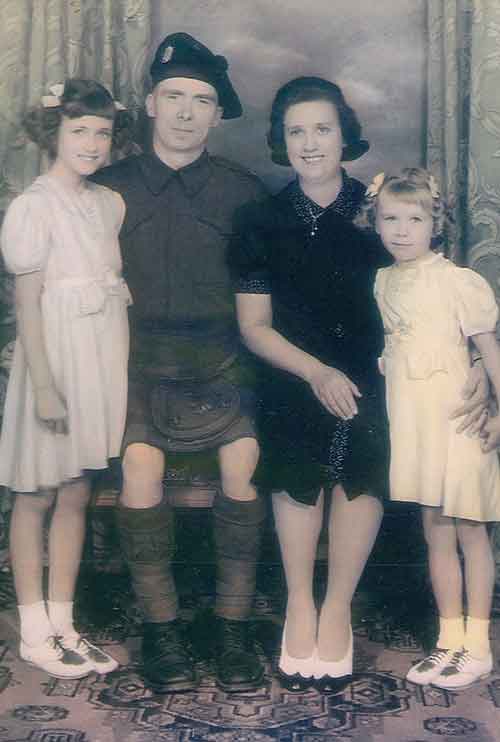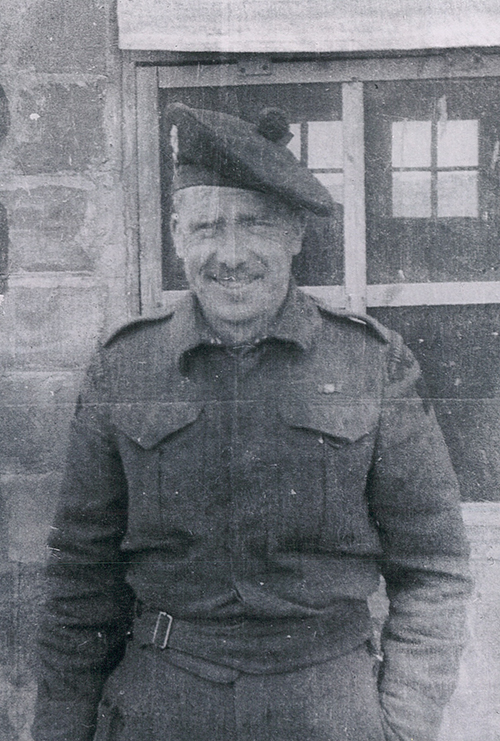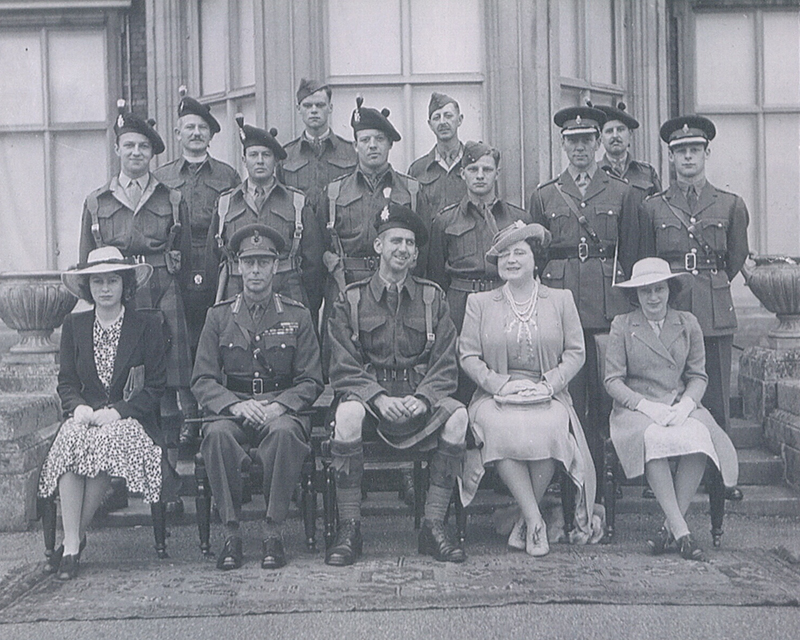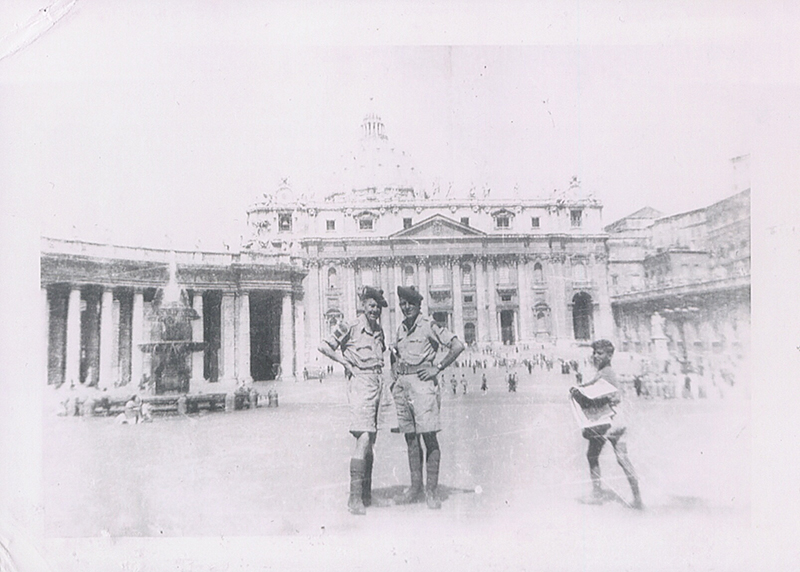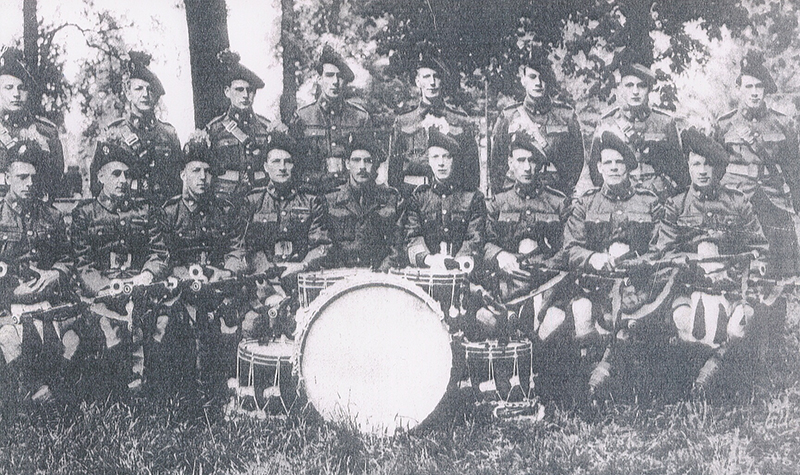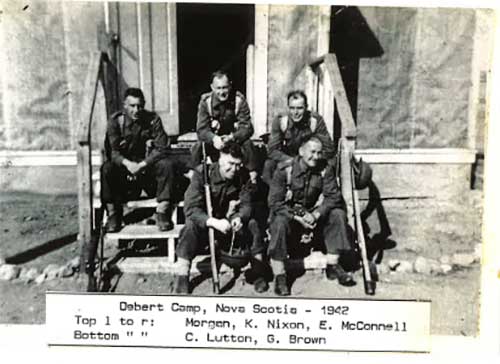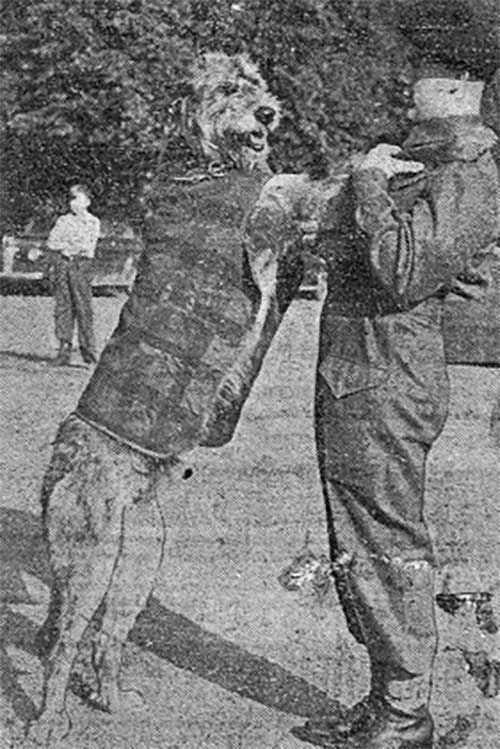Wall of Service
Column
20
Row
7
CHARLES JOSEPH LUTTON/"C" COMPANY
THE IRISH REGIMENT OF CANADA
23/09/1939 - Militia
20/06/1940 - Active
22/06/1945 - Repatriation Draft
(Joure, Holland)
07/08/1945 - Draft #1/Train #153
(Toronto, Canada)
- Reunited with wife & two young daughters
The Irish Regiment of Canada
Veterans Association 1945-1963
FIOR GO BAS: FAITHFUL UNTO DEATH
THE IRISH REGIMENT OF CANADA/WAR DIARY:
October 28, 1942 1100 hrs. Train arrived Halifax. On detrainment the Regiment lined up on the Embarkation Pier. The Embarkation Officer addressed the Regiment and explained the ships regulations. The Regiment commenced to embark at 1200 hrs. The remainder of the day was spent finding quarters and as there were approximately 12,000 people on board this was at times difficult. Weather fair
October 30, 1942 (Aboard Ship/R.M.S. “QUEEN ELIZABETH”) Sailed from Halifax escorted by aircraft. There were several boat and A.A. drills. Weather fair, sunny, calm
November 1, 1942 (Aboard Ship) During the day the ship detoured 300 miles to avoid submarines. All ranks were issued 6 tins of U.S. Army field rations. They also received their Pay Books and a free issue of fifty cigarettes. All port-holes below the main deck were ordered to be closed. In the evening there was a concert in A Mess Hall with the pipe band taking part. There was also a concert in the Officers Lounge. Weather fair, sunny, calm
December 28, 1942 (Aldershot) The Commanding Officer, Lt. Col. R.C. Clark told the officers that then Regiment would in the near future be transferred to the 5th Canadian Armoured Division as part of the (11th) Motorized Infantry Brigade. No other details are yet available. This information was passed on the Regiment in the afternoon. Everyone was sorry at the prospect of taking down the green patch after being with the 4th Division ever since it was formed
January 15, 1943 (In the field) The 5th Division Maroon patches have been received by the Quartermasters. Capt. G.R. Duncan, 5th Division Field Security personnel contacted the unit
October 24, 1943 (Aboard ship /S.S. “MONTEREY”) In the morning the ship cast off and sailed out of the MERSEY RIVER and steamed NORTH. In the evening we passed through the boom in the FIRTH OF CLYDE and dropped anchor off GOUROCK. It was just a year ago less two weeks that the Regt. arrived in this same place having sailed from CANADA...Weather – warm and clear.
November 4, 1943 (Aboard Ship) At 1730 hrs we passed through the famous STRAITS OF GIBRALTAR ... When night fell we were in the MEDITERRANEAN, destination still unknown. Weather clear, warm.
November 6, 1943 (Aboard Ship) At 1805 hrs with everything going normally 3 rings suddenly sounded on the general alarm. All ranks except those on duty were warned to get below decks as we were being attacked by enemy aircraft. All our anti-aircraft guns opened fire, 3" guns forward and aft, OERLIKONS on the boat deck and BREN guns. The BREN gunners were men from C Coy of THE IRISH REGIMENT. The enemy torpedo bombers continued their attack for a full half hour. After the action had subsided the MONTEREY made a wide circle and then reduced speed. At 2100 hrs. the CAPTAIN announced over the PA system that net and raft details and deck control officers were to proceed to their posts at once. We knew then that the enemy air-craft had succeeded in part of their task. It was revealed that we were to stand by to pick up survivors. Immediately all ranks on board made precautions to take part in the rescue work. The IRISH on special duties included deck control officers, net and ladder details, and raft details ... Those with no particular duties were busy making the survivors at home on our vessel ... Several lifeboats manned by men of THE IRISH REGT made two and three trips to the stricken ship and back, picking up survivors. Weather cloudy, mild.
November 7, 1943 (Aboard Ship) A destroyer stood by while the rescue work was going on. One vessel from which we were picking up survivors could be seen settling down at the stern. This was the SANTA ELENA, an AMERICAN vessel of the GRACE LINE ... In all, over 1300 survivors were rescued by the S.S. MONTEREY. There was a small number from a NETHERLANDS vessel as well as practically all the troops from the SANTA ELENA ... Many of the IRISH spent the day in their bunks taking a well-deserved and much needed rest ... Weather fair, mild.
November 10, 1943 (Aboard Ship) At dawn the MONTEREY’s engines were silent and the first question everyone asked was, where are we? Up to this time no hint whatever had been given as to our destination. When the morning mist had lifted a world famous landmark, MOUNT VESUVIUS, told us we were in NAPLES HARBOUR….Weather – bright and warm.
April 22, 1944 (S. ELIA FIUMERAPIDO / Map. 891266 Scale 1/50,000 Sheet 160 1) The Bn change over was completed by 0335 hrs. Our casualties during the move were 2 wounded, both from A. Coy, B227989 Pte. WATSON S E A, and B47232 Pte. WISE F H . . .
At the break of the light on the first day in the line, everyone was able to look back down the RAPIDO RIVER valley from their vantage points on the high ground. It was like seeing a newsreel in Technicolor of CASSINO and MONASTERY HILL in headlines. The MONASTERY itself in ruins, could be seen on the top of the hill. The town of CASSINO had been practically obliterated by the ARTY barrages and air bombings. Over the valley there was a continual pall of smoke that swung to and fro with every change of the wind. It was a screen laid down by the Allied forces to prevent the enemy from seeing our activities in the daytime. In particular, a bridge over the RAPIDO RIVER which is the main supply route to the CASSINO area had to be concealed. Daylight movement anywhere in the valley without the smoke is practically an impossibility, as the enemy holds the mountains which overlook all our positions. In our particular sector we are high up from the valley floor but the enemy is still higher on MT CIFALCO which towers over the Bn area.
The men in the forward coys feel as though they are under observation all the time. In places they are on bare rock-strewn land. It is impossible to dig trenches so Sangars have been built. A Sangar is a pile of rocks that a man builds up around him in place of a slit trench.
The water supply is a big problem. There are wells in certain areas which can be reached by the platoon without too much difficulty and danger but others have to be supplied by mule train.
Without mules we could barely exist. Water, food, ammunition are brought up by the mules at night. The CQMS’s have an extremely arduous task. At jeephead near the ford in the river, they are constantly under shell fire but it is here they have to unload the jeeps coming from A Echelon and load the mules. CAPT N H SHAW is in charge of the jeephead with an able 2 IC in RSM MCKELVEY. The QM’s with their Coy guides take the respective mule trains out beginning at approximately 2100 hrs. Jeeps are only allowed out of A Ech every half hour so that there is no waiting around outside jeephead. Under our command is a platoon of ALGERIAN muleteers who take care of the mules and lead them out at night behind the Coy guides.
This is undoubtedly the most picturesque front that we have been in yet but is also the hardest to supply. Weather – Bright and warm.
September 11, 1944 It was made known that the Army Intention required 11 CIB to capture the CORIANO RIDGE, after which the 4th Br. Div. would pass through across the MARANO, while 1st Cdn. Div. made a crossing on the right. This operation was to take place on the night 12-13 Sept. 44....
September 12, 1944 The Regiment moved up for the attack on CORIANO on the evening of the 12th. An unusual event took place prior to this, however. Officers of the London Irish Rifles joined our Officers for dinner at 1830 hrs. and wished us well in our battle. Our senior officers were presented with the light blue feather hackles which the London Irish Officers wear in their bonnets and members of both pipe bands entertained us during the dinner. Lt. Col. R. C. Clark wore the hackle of the London Irish in his bonnet during the battle of the following day.
September 13, 1944 The attack formed up behind the BESANIGO RIDGE. From this feature the CBH (Cape Breton Highlanders) moved across the CORIANO RIDGE, cutting the town off from the North. At the same time the Perth Regt. moved across and cut the town off from the South. At 0630 hrs. “C” Company of the Irish Regiment, under Capt. Bill Mitchell, passed through the CBH left flank and began clearing the town from the right. Mines, mortaring and shelling and snipers all had to be met, and “C” Company, although its casualties were numerous was lauded afterwards on all sides for the magnificent job it did during the commencement of operations.
While this was going on “A” Company was giving protection to RCE Sappers who were bridging the BESANIGO RIVER, a small stream which flowed through the valley before the CORIANO RIDGE. Fire from a high feature on the South-West edge of CORIANO, known as CASTELLA, seriously hampered the progress of the clearing, until “C” Sqdn. of the 8 NBH (New Brunswick Hussars) under Major McEwen neutralized it with gun and machine gun fire. Meanwhile “D” Company moved through “C” Company and completed the clearing of the town from North to South, while “B” Company, under Capt. Bill Elder took up a position on the right flank,also covering the CASTELLA feature. During this operation Major Frank Southby, O.C.”D” Company was seriously wounded, since died of wounds. An 8 NBH tank picked him up through an escape hatch on the underside of the tank, when efforts made by the medicals were met with enemy sniping and MG fire. Major Armstrong went into CORIANO and took over command of “D” Company after Major Southby was wounded… The main part of the town was cleared by the night 13-14 Sept. 44 after eleven hours of fighting…
September 14, 1944 In the morning of 14 Sept. ‘44 the operation was completed with the clearing of the CASTELLA feature. During the day the 4th Br. Div. passed through us, enabling the Regiment to move back to SAN GIOVANNI on the night of 14th Sept. ‘44
September 15, 1944 The Regiment had a chance during this period to clean up, effect the routine maintenance and above all, to rest after a long and strenuous operation which began with the cracking of the Gothic line at Hill 120
September 16, 1944 A letter was received by Brig. Johnson from General Sir. O. Leese, congratulating the Bde. on the taking of CORIANO
September 17, 1944 A Memorial Service for our wounded and slain was held this morning at 0900 hrs. Lt. Col. R.C. Clark read the roll of our dead. Both Maj. Gen. B. Hoffmeister and Brig. I.S. Johnson were present. The sermon was delivered by Padre D.P. Rowland
February 14, 1945 (Cattolica) Final preparations for Exercise “GOLDFLAKE” were completed. In the afternoon the C.O., Lt.Col. L.H.C. Payne, held a final “O” Op and gave out his last admin. instructions to the Coy Commanders for the move
February 18, 1945 (Final staging area between LEGHORN and PISA) This morning there was a Regimental Inspection under Coy arrangement, where all ranks were informed that we were leaving ITALY and going to FRANCE. Security was emphasized and all personnel removed all identification including hat badges and transport painted out all Cdn. or Div. signs. All troops are confined to the immediate area. The REGIMENT has been fifteen months in ITALY where they have seen some hard fighting and are looking forward to getting to FRANCE
May 8, 1945 Today came the news we have been waiting for, for nearly six years. To-morrow Germany will surrender. It leaves one with a curious mixture of feelings. Mostly there is just a feeling of thankfulness and relief. But there is no great sense of extreme joy, but just a quiet acceptance and thoughts of all those fellows who waited and fought for this one day, and died in ITALY and HOLLAND that the rest of us might carry on to this great day. To many of us it means no more crouching in slit trenches, or waiting for the next shell to land, and wondering how much longer your luck will last, no more dawn attacks or night patrols. Weather mild
May 9, 1945 At 0800 hrs. this morning the war with GERMANY officially ended with the surrender of all the GERMAN ARMIES, except some isolated groups fighting in CZECHO SLOVAKIA and AUSTRIA The Regiment has fought in two theatres and made a proud name for itself. We can look back on a fine record of battles we have won. There were many grim moments and days when we wondered about the future, but out of every battle through superb leadership and the valiant hearts of good fighting men the IRISH came with flying colours, and added laurels that makes one proud to belong to such a fine Regiment. There are not many left of those who originally joined the Battalion when it was mobilized and it has been a long time since those days at Camp Borden to the little village of SIDDEBUREN in NORTH HOLLAND. But the war with GERMANY is over and won. Weather warm
May 10, 1945 Yesterday and today are holidays and there are no parades. This is a quiet area and many took advantage of the days and went into GRONINGEN which is the largest city in NORTH HOLLAND. Victory celebrations are going on in all towns and villages and the houses and streets are decorated with flags and HOLLAND is happy again after 4 and a half years of GERMAN domination. Weather fair and mild
THE IRISH REGIMENT OF CANADA - IST BATTALION
5TH CANADIAN ARMOURED DIVISION, 11TH INFANTRY BRIGADE
ENGLAND 1942-1943/ITALY 1943-1945/HOLLAND 1945
BATTLE FIELDS (ITALY): ORTONA, ORSOGNA, ARIELLI, MT. CASSINO, MELFA RIVER, CEPRANO, POFI, FOGLIA RIVER, MONTECCHIO-HILL 120, TOMBA-DI-PESARO, ST. ANDREA CHURCH, BESANIGO RIDGE, CORIANO, USO RIVER, SAN MAURO, RUBICON RIVER, SAVIO RIVER, MENSA, BEVANO RIVER, MONTONE RIVER, MEZZANO, LAMONE RIVER, FOSSO VECCHIO, NAVIGLIO, FOSSO MUNIO, SENIO RIVER, CONVENTELLO, SAN ALBERTO (HOLLAND): ZETTEN, NIJMEGEN ISLAND, NEDER-RHINE, ARNHEM, OTTERLOO, ERMELO, SIDDEBUREN, WAGENBORGEN, BORGSWEER, FARMSUM, DELFZIJL
HALIFAX, AUGUST 5, 1945
NEARLY 12,000 TROOPS LAND WITH CRERAR
(Large Contingent of THE IRISH REGIMENT OF CANADA On Board)
Nearly 12,000 of Canada's fighting men and women arrived at this port today with Gen. H.D.G. Crerar, the 1st Canadian Army commander, who was given a noisy welcome to Canada by the people of this port and an equally noisy farewell by his men aboard the big troop transport Ile-de-France (Gen. Crerar bade his final farewell to his troops Saturday as the Ile-de-France neared the shores of home. In the simple, straightforward manner which marked all his actions in this war, he said a few words of hail and farewell and wished them all the best that life can afford, and which you so richly deserve).
A launch with an army band aboard escorted the trooper into harbour and to the quayside, where a Scottish pipe band, civilian entertainers and hundreds of relatives and friends lined the sides of the weather-beaten pier to welcome the veterans home. RCAF planes soared overhead and ships whistles deafening to greet them.
TORONTO, JANUARY 16, 1946
TORONTO OFFICIALLY WELCOMES HOME 1ST BATTALION/ THE IRISH REGIMENT OF CANADA
At about 1500 hrs the train pulled in to the special siding behind the Coliseum and the companies formed up beside the Colour Party drawn from the 2nd Battalion and 1st Battalion Vets with the pipes playing. The Regiment marched into the Coliseum and formed in mass, surrounded by admiring friends and relations. After a short address of welcome by the Mayor of Toronto and the Officers commanding M.D.2 and a reply by Col. G.C.A. Macartney, the Colours were marched off, and the Battalion was dismissed for the last time
